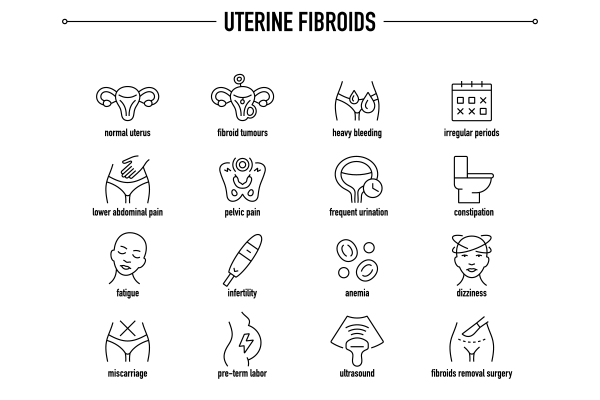
Uterine fibroids are a major health concern among women. It is the most common benign tumour of the uterus and a major source of morbidity, affecting 68.6% of women. In 2019, uterine fibroids accounted for 9.64 million incident cases and 226.05 million prevalent cases globally.1
These non-cancerous growths are often asymptomatic, making regular gynaecological examinations important for early diagnosis and treatment, as they can impact a woman's quality of life. Let's effectively deal with this health issue by understanding uterine fibroid symptoms, its causes, treatment options, and postoperative care.
Synopsis
What are Uterine Fibroids?
Uterine fibroids are also called leiomyomas or myomas. These are non-cancerous growths made of connective tissue and muscle that develop in or on the wall of the uterus. These are benign and affect mostly women by the age of 50. They vary greatly in size and number. A woman can have a single fibroid or many, which can be as small or large as a grapefruit. They can grow slowly or rapidly, with most of them remaining asymptomatic, which gets diagnosed during a pelvic examination.
Although small fibroids do not require uterine fibroids treatments, large fibroids can cause significant health issues and symptoms, requiring medical treatment.
Uterine Fibroids Symptoms

When the symptoms of uterine fibroids are exhibited, they usually differ based on their location, size, and quantity. The most common signs of uterine fibroids include:
-
Heavy menstrual bleeding, prolonged or painful periods
-
Pain during sex
-
Lower back pain or pelvic pain
-
Frequent urination or trouble urinating
-
Bleeding between periods
-
Long-term vaginal discharge
-
A feeling of fullness in the abdomen
-
Increased abdominal enlargement
-
Constipation
Consult our gynaecologists in Patiala if you are experiencing the above fibroids symptoms.
Causes of Uterine Fibroids
The exact cause of uterine fibroids is still unclear, but several factors can increase their risk. These uterine fibroids causes include:
-
Hormones: Estrogen and progesterone hormones play a role in their development, as studies have shown that these hormones stimulate the growth of these fibroids.
-
Genetics: A family history of fibroids makes one more likely to develop them. Also, gene changes are seen in fibroids, which differ from typical uterine muscle cells.
-
Age: They mostly occur during a woman’s reproductive age, between the ages of 30 to 50 years.
-
Growth factors: Other growth factors, such as insulin-like growth factors, can affect fibroid growth.
-
Lifestyle factors: Obesity, having a diet rich in red meat, and alcohol consumption can increase the risk of developing fibroids.
-
Other risk factors: Late age of menopause, not having children and early onset of menstruation can increase the risk of developing fibroids.
Uterine fibroids can cause several complications during pregnancy, which can be a significant concern for women of reproductive age. Here are some of the potential complications:
Complications During Pregnancy
1. Miscarriage
Women with fibroids are at a higher risk of miscarriage, especially in the first trimester.
2. Pain
Fibroids can cause significant pain during pregnancy, particularly if they grow larger due to increased hormone levels. This pain can be due to the fibroid outgrowing its blood supply, leading to a condition known as "red degeneration."
3. Bleeding
Some women may experience bleeding during pregnancy, which can be concerning and require medical attention.
4. Placental Abruption
This is a serious condition where the placenta detaches from the uterine wall before delivery, which can deprive the baby of oxygen and nutrients and cause heavy bleeding in the mother.
5. Preterm Delivery
Women with fibroids are more likely to deliver preterm, meaning before 37 weeks of pregnancy.
6. Fetal Growth Restriction
Large fibroids can restrict the growth of the fetus by reducing the space available in the uterus.
7. Malpresentation
Fibroids can affect the position of the baby in the womb, leading to issues such as breech presentation (where the baby is positioned feet-first instead of head-first).
8. Obstructed Labor
Large fibroids can obstruct the birth canal, making vaginal delivery difficult and increasing the likelihood of a cesarean section.
Managing Fibroids During Pregnancy
-
Regular Monitoring: Frequent ultrasounds and check-ups to monitor the size and position of fibroids.
-
Pain Management: Safe pain relief options, such as acetaminophen, under the guidance of a healthcare provider.
-
Healthy Lifestyle: Maintaining a healthy diet and regular, gentle exercise to support overall well-being.
Lifestyle Changes to Treat Uterine Fibroids
|
Category |
Description |
Examples |
|
Dietary Changes |
Adjustments in diet to help manage symptoms and potentially slow fibroid growth. |
Increase fibre intake (whole grains, legumes, vegetables, fruits) Focus on anti-inflammatory foods (berries, leafy greens, nuts) Reduce red meat and dairy with added hormones |
|
Weight Management |
Maintaining a healthy weight reduces estrogen levels and fibroid growth. |
Regular exercise Balanced diet Avoiding processed foods |
|
Stress Management |
Techniques to reduce stress can impact hormone levels and fibroid growth. |
Yoga Meditation Breathing exercises |
| Herbal Supplements |
Use of natural supplements to manage symptoms. |
Green tea extract Curcumin (turmeric) Vitex (chaste berry) |
|
Physical Activity |
Regular exercise improves blood circulation and reduces inflammation. |
Walking Swimming Pilates |
|
Alternative Therapies |
Non-traditional treatments to alleviate symptoms. |
Acupuncture Homeopathy Bodywork therapies (massage) |
Uterine Fibroids Treatment
The treatment options for uterine fibroids depend on their size, number, location, and symptoms you are experiencing. Small asymptomatic fibroids are left alone and are monitored through regular pelvic exams or ultrasounds. When a fibroid is causing symptoms like excessive bleeding or is affecting your life, it needs proper treatment. The doctor will decide the best treatment option after considering your fertility goals and other factors.
Common treatment options available include:
-
Medications: Over-the-counter pain medications, iron supplements, birth control pills, gonadotropin-releasing hormone (GnRH) agonists, and oral therapies may be used to relieve symptoms or shrink fibroids.
-
Minimally invasive procedures: These procedures require small incisions and offer faster recovery times and fewer complications. Uterine Artery Embolisation, Laparoscopic Radiofrequency Ablation, Laparoscopic or Robotic Myomectomy, Hysteroscopic Myomectomy, and Endometrial Ablation are techniques used to remove or shrink fibroids.
-
Surgical methods: Large or numerous fibroids require surgery through traditional methods. These are Abdominal Myomectomy (fibroid removal surgery) and Hysterectomy (removal of the uterus, a permanent solution for uterine fibroids).
-
Non-surgical methods: A non-invasive method can also be used to destroy fibroids, such as MRI-guided Focused Ultrasound Surgery.
Consult our gynaecology hospital in Patiala if you need fibroids treatment.
Post-Operative Care
The recovery after the fibroid treatment will depend on the type of procedure performed. The common post-operative care instructions include the following:
-
Rest is very crucial after uterine fibroid surgery. Take adequate rest and avoid lifting heavy items or strenuous activity for a few weeks.
-
Your doctor will recommend anti-inflammatory and pain relievers to alleviate pain and discomfort after the surgery. Make sure to take them as prescribed.
-
Don’t miss follow-up appointments, as it is important to monitor your recovery and ensure there are no complications.
-
To promote faster recovery and healing, consume a balanced diet rich in fruits, vegetables, and fluids, as it also helps reduce constipation.
-
Get emotional support from family through counselling or support groups, as fibroid or uterus removal can affect your mental well-being.
FAQ's
Mostly, the fibroids get diagnosed during a regular pelvic exam. In case you experience heavy bleeding or other symptoms of uterine fibroids, the doctor may ask you to undergo certain diagnostic tests to determine their size and location. These are MRI, ultrasonography, hysteroscopy, CT scan, laparoscopy, and others.
Usually, fibroids cannot be prevented, but you can reduce the risk of their development by maintaining a healthy weight and getting regular pelvic exams. In the case of a small fibroid, get regular monitoring done to avoid it from getting bigger and more problematic.
Yes, uterine fibroids can affect fertility and pregnancy. With proper treatment and a monitoring plan, you can get pregnant. However, if the fibroids are large, they can cause complications such as placental abruption, preterm delivery, C-section delivery, and others. Consult with our doctor for guidance and appropriate treatment.
Yes, large fibroids can cause bloating or enlargement of the abdomen, making your stomach look bigger and sometimes resembling a pregnant woman.
To schedule an appointment at Manipal Hospitals, Patiala, contact or visit our website.





















 6 Min Read
6 Min Read



















